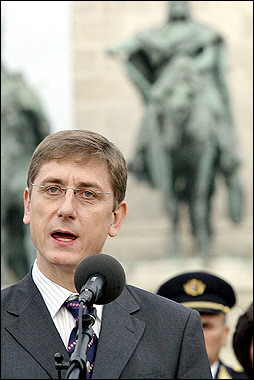
HUNGARY BREAKS RANKS WITH THE EU AND ITS NEIGHBORS ON THE NABUCCO PROJECT
Publication: Eurasia Daily Monitor Volume: 4 Issue: 51
By:

Hungary’s Socialist-led government has apparently decided to support Gazprom’s Blue Stream project, through which Russia seeks to capture an ever-growing share of the European Union’s gas markets. Made public on March 12, the Hungarian government’s move could — unless reversed by EU suasion — kill the EU’s high-priority Nabucco pipeline project for Caspian gas, which the EU regards as key to avoiding collective overdependence on Russian-supplied gas. The government’s decision equally snubs U.S. advice and also breaks ranks with Hungary’s otherwise close partner Austria, initiator of the Nabucco project.
Prime Minister Ferenc Gyurcsany portrays the Nabucco project as “a long dream and old plan. But we don’t need dreams, we need gas.” While conceding that total dependence on Russia for gas is risky, he seeks Russian supplies from Gazprom through extending Russia’s Blue Stream pipeline via Turkey and the Balkans into Central Europe. As he sees it, “Blue Stream is backed by a very strong will and a very strong organizational power” (interview with International Herald Tribune, March 12). Moreover, elements in the Hungarian government are tempted by Gazprom’s promises to turn Hungary into a “hub country” for distribution of Russian-delivered gas in Central Europe, instead of Austria becoming a hub country for Caspian gas.
The Hungarian government’s move seems timed to torpedo the EU’s decision, at its March 8-9 summit in Brussels, to reconfirm that the Nabucco project constitutes a top priority for the EU. If Hungary opens the gates into Central Europe for Gazprom’s pipeline, the market for Nabucco-delivered Caspian gas would shrink or even disappear, preempted by Russian-delivered gas (some of it, ironically, of Central Asian provenance, delivered however via Russia by Gazprom at a high markup). Thus, investors would be dissuaded from financing the Nabucco project. If the EU Berlin summit’s decision seemed bound to encourage investors, the Hungarian government’s public step could offset that effect, to Gazprom’s advantage.
In this sense, the Hungarian government seems to have “ended the ambiguity” (see EDM, January 16) that surrounded its position. As an EU member, Hungary was a founding member — along with Austria, Romania, Bulgaria, and Turkey — of the Nabucco pipeline consortium. It will almost certainly not drop out and will continue to wish it well in words. But the government has been negotiating with Gazprom in parallel, and was all along in a position to cut off Nabucco from Central Europe by dint of Hungary’s geographic location. This apparently is about to happen, if the government’s decision stands.
Gyurcsany’s latest arguments repeat those offered to the visiting U.S. Secretary of State Condoleezza Rice and Deputy Assistant Secretary Matt Bryza last year, when Hungarian government officials deprecated projects to bring Caspian gas directly to Europe as unrealistic “distant prospects” because of insufficient volumes; whereas Gazprom had the gas volumes at hand and could ostensibly prolong its Blue Stream pipeline from Turkey soon.
Such an assessment of the Nabucco project is clearly out of date. The EU officially endorsed it in June 2006 as a top priority and reaffirmed that position at the Berlin summit. The European Bank for Reconstruction and Development is prepared to finance 70% of the costs of pipeline construction from eastern Turkey to Austria. The United States is working intensely with Azerbaijan and Kazakhstan to supply massive volumes of gas into this pipeline. The volumes are already available in Azerbaijan to supply the pipeline’s first phase of 16 billion cubic meters annually at full capacity, and Kazakhstan agreed last month to participate in the planned trans-Caspian gas pipeline (see EDM, March 2).
Addressing an energy conference on March 8 in Istanbul, Bryza noted that Azerbaijan alone (even before Kazakh gas comes on stream) can supply sufficient gas for the Nabucco pipeline’s first phase before 2012 — that is, by the time construction would be completed — and for an additional pipeline after that date, for a total of 20 billion cubic meters annually. “Rumors that Azerbaijan’s reserves are insufficient are simply disinformation,” he noted (Turkish Daily News, March 9).
Thus, the Hungarian government’s devaluing the Nabucco project at this juncture as a distant dream seems an excuse to side with the rival Gazprom project. In a March 6 speech on foreign policy to the Hungarian Academy of Sciences and a March 7 speech to diplomats accredited to Hungary, Gyurcsany invoked a further excuse — namely, the lack of a common EU policy on energy, which “makes it logical for us to go for bilateral deals to solve our energy problems” with Russia, as do other EU member countries (MTI, Interfax, March 6, 7).
Again, this assessment runs counter to the recent evolution toward common EU policies on energy issues, specifically on the Nabucco project. While other EU member countries do strike risky bilateral energy deals with Russia, they as a rule do not torpedo existing EU projects. Hungary seems about to earn that dubious distinction through its Socialist-led government (see EDM, June 30, July 3, September 20, 2006, January 16, 2007).



